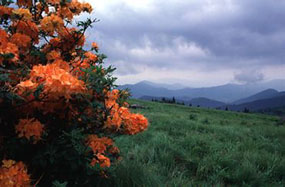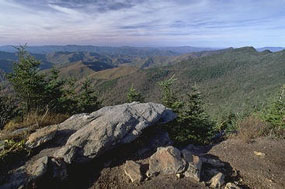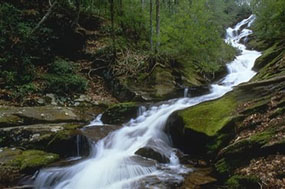 The Black Mountains of North Carolina, located near
Asheville in the western end of the state, are home to the highest peaks
in the eastern United Sates. They are also home to an abundance of plant
and animal species, many of which have less and less habitat available to
them. The Blacks are one of the last wild areas of any significant size
in the Southeast. While other areas have suffered from rampant roadbuiling
and development, ill-advised timber harvesting, and other impacts, the Blacks
have, for the last 70 years, been relatively well taken care of.
The Black Mountains of North Carolina, located near
Asheville in the western end of the state, are home to the highest peaks
in the eastern United Sates. They are also home to an abundance of plant
and animal species, many of which have less and less habitat available to
them. The Blacks are one of the last wild areas of any significant size
in the Southeast. While other areas have suffered from rampant roadbuiling
and development, ill-advised timber harvesting, and other impacts, the Blacks
have, for the last 70 years, been relatively well taken care of.
This picture shows the Black Mountains as
viewed from Roan Mountain. Bryan Hodges.
 Much of the Black Mountains area is in public
ownership--within Mt. Mitchell State Park, the Blue Ridge Parkway, or Pisgah
National Forest. These lands form a sizable core area of wild plant and
animal habitat. Much of the old growth forest in the area--usually on steep
slopes that 1920s loggers could not profitably scour--is on National Forest
land. Many of the highest peaks, with their spruce/fir forests (currently
suffering from acid rain), are in Mt. Mitchell State Park. Because of this
public ownership and a current trend of private landowner support, the opportunity
exists to conserve the invaluable pristine lands of the Black Mountains
for the greater public.
Much of the Black Mountains area is in public
ownership--within Mt. Mitchell State Park, the Blue Ridge Parkway, or Pisgah
National Forest. These lands form a sizable core area of wild plant and
animal habitat. Much of the old growth forest in the area--usually on steep
slopes that 1920s loggers could not profitably scour--is on National Forest
land. Many of the highest peaks, with their spruce/fir forests (currently
suffering from acid rain), are in Mt. Mitchell State Park. Because of this
public ownership and a current trend of private landowner support, the opportunity
exists to conserve the invaluable pristine lands of the Black Mountains
for the greater public.
Photograph taken from Black Mountains Crest
Trail. Ben Walters.
Plan Revisions
An important opportunity to influence the Forest Service's management of their land in the Blacks is the public comment period of the Service's plan revision process. In a little over a year, the National Forests in North Carolina will revise their management plans and the public will be given a chance to express opinions about the appropriate manner in which to manage different parts (management areas) of the Forests. The Service draws up a series of "alternatives" for each area and then chooses one from this list. With good planning and preparation, we can influence every alternative (by submitting issues, which are common to all alternatives) in addition to drawing up a comprehensive, viable conservation alternative.
To learn a little about the history of national forests in the east and more about the plan revision process, read this article submitted by Terry Seyden. Mr. Seyden is the Public Affairs Officer for National Forests in North Carolina. Or, to view the current Draft Alternatives for the plan revision process, visit this site.
Roadless Areas
 The U.S. Forest Service has proposed a time-out on road construction
in some of the most remote, steep and rugged areas on the lands it manages,
including most national forests of the southern Appalachians. These places
are called "roadless areas." The moratorium is a very modest step,
especially in the East, where undeveloped land is becoming scarce. The time-out
may last up to 18 months, during which time the Forest Service also will
revamp its overall transportation policy.
The U.S. Forest Service has proposed a time-out on road construction
in some of the most remote, steep and rugged areas on the lands it manages,
including most national forests of the southern Appalachians. These places
are called "roadless areas." The moratorium is a very modest step,
especially in the East, where undeveloped land is becoming scarce. The time-out
may last up to 18 months, during which time the Forest Service also will
revamp its overall transportation policy.
The remaining fragments of unroaded forest in the southern Appalachians
are some of the best hiking, camping hunting and fishing lands in the nation.
They're also unprotected and increasingly scarce. Speak out today! Let's
keep our options open and give these lands a chance to remain natural.
Photograph by Ben Walters.
Click here
to support roadless areas!
Though the public lands occupy most of the region's high elevation areas,
private lands are also critical pieces of the wildland puzzle. Two of the
most significant private landowners in the Blacks recently established conservation
easements on their land, protecting large tracts in exchange for a tax break.
One of these owners is the city of Asheville, which just protected the watershed
which serves the city with clean, pure water. Conservation
easements offer the potential for everyone to gain and are a useful
tool in the effort to protect this land.
[top]
The goal of the Black Mountains Program is threefold:
(1) Build an identity for the Black Mountains as a discrete and recognizable region, unique in its biological value as a rich wildland.
(2) Provide education about the area and its virtues
(3) Work with local communities to develop a conservation plan for the area that would ensure the protection of its inherent values.
Part of our work in providing education about the Blacks includes our
continued exploration of the natural values of the mountains. The Citizen's
Old Growth Inventory, the results of which are represented in the clickable
map below, is part of that exploration. Rob Messick, working with the Western North Carolina Alliance and
with SAFC, was responsible for collecting
the old growth data represented by that map.
| Map of Black Mountains Area |
Map of Old Growth in Grandfather Ranger District (see section below on Big Ivy) |
More about the mapping involved with the Black Mountains conservation
project can be found here.
[top]
An inventory of the Big Ivy area within the Blacks has been completed by Alan Smith, a biologist out of Mars Hill College. Alan was contracted by the Black Mountains Program to conduct this survey - his results come as good news to those who have known that quality old growth sites exist in Big Ivy. Click here to read his report.
 Outreach within the communities
surrounding the Black Mountains is a large portion of the program. This
consists of giving presentations to civic groups, hosting speakers, providing
information about private and public land conservation, and working with
the local schools.
Outreach within the communities
surrounding the Black Mountains is a large portion of the program. This
consists of giving presentations to civic groups, hosting speakers, providing
information about private and public land conservation, and working with
the local schools.
If you would like for someone to give a presentation to your local group or class, please contact us at 828-253-0095 or 828-252-9223 or email us using the links at the bottom of the page. We can arrange for a video presentation, lectures on a variety of topics, or help with fieldtrips. These services are available in Buncombe, Mitchell, Yancey, Avery, and McDowell counties and are free of charge.
To read about a past fieldtrip, click on the picture to the upper right.
The Black Mountains are rich in history and lore, including events stories
and personalities. We will be gradually adding items to this section of
the web page.
Big Tom Wilson (son of Big Tom Wilson).
The Trees of Mount Mitchell
Now available - Get yours today!! The Black Mountains Interactive CD-Rom Renowned for their dramatic natural beauty, the Blacks are a treasure
trove of biological diversity, cultural richness, and recreational opportunities.
Along with exploring the abundant resources of the Blacks, this CDROM examines
ways this important mountain chain can be protected for future generations.
You will learn about: Explore and enjoy the majesty and wonder of the Black Mountains with this CDROM. It is an adventure you will not forget! Send $12 to The Black Mountains Program, 34 Wall St., Suite 805F, Asheville, NC 28801-2710 and we will send you a copy to enjoy. The $12 covers the CD and shipping and handling. |
Mackey Mountain Trail GuidesTrail guides for the Mackey Mountain Wild Area. |
To find out what is happening in the Blacks and throughout the Southeast, click here. This page is continually updated with recent events concerning our area.
If you are interested in getting involved in the Black Mountains Program, or if you would like more information, please contact SAFC or SAHC by clicking below. We encourage you to let us know why you're interested, how you think we should proceed, and what you feel you could bring to the project.
Visit the web site for the Black Mountains Initiative, a photographic documentary project of the Black Mountains area.
Also, please visit the Black Mountains Program's sponsors web sites. Both have recently been updated and are full of timely, quality information.
SAFC's Web Site | SAHC's Web Site